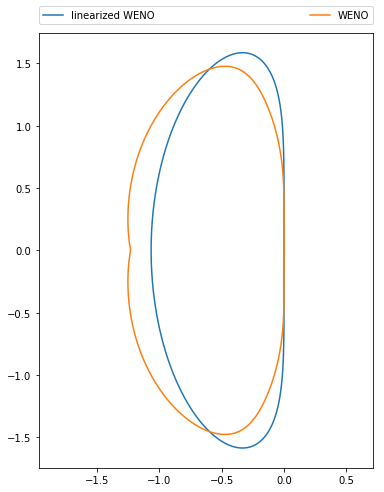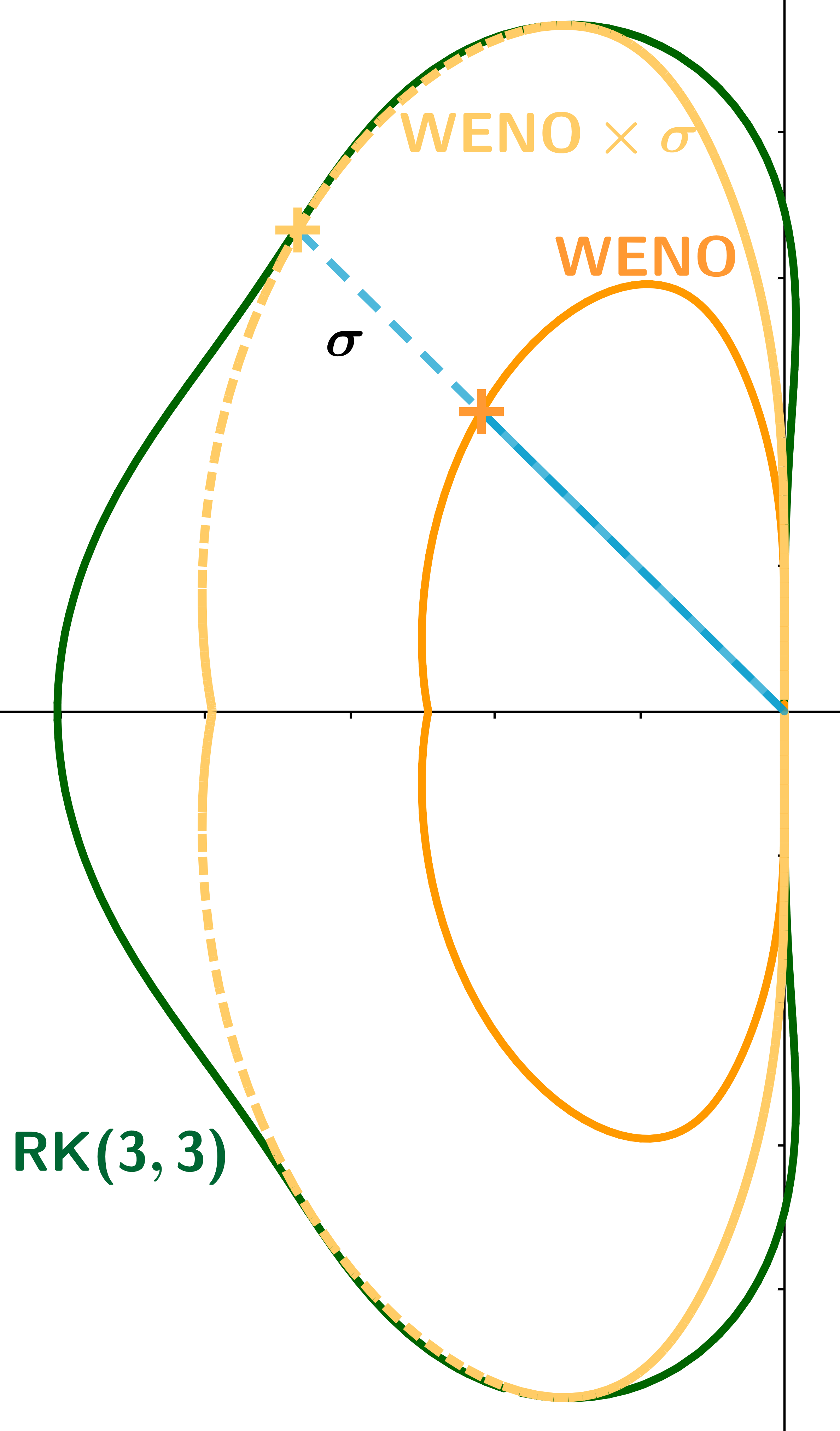Vlasov-Poisson equation
Vlasov equation plays an important role in the modeling of plasma physics, it is a non-linear transport in $(x,v)$ of a density distribution $f = f(t,x,v)$; coupled with Poisson equation for estimate electric field $E=E(t,x)$:
$$ \begin{aligned} & \begin{cases} \partial_tf + v\partial_xf + E\partial_vf = 0 \\ \partial_xE = \int_{\mathbb{R}}f\,\mathrm{d}v - 1 \end{cases}\\ & \quad x\in\mathbb{\Omega}\subset\mathbb{R},\ v\in\mathbb{R} \end{aligned} $$

High order methods are needed in phase space $(x,v)$ to study filamentation.
Simplified model
We study the stability problem on a simplify model: $$ \partial_tu + a\partial_xu = 0. $$ We discretize in space with WENO method [1], and we test various Runge-Kutta methods for the time integrator. We apply von Neumann analysis on space discretization to study amplification factor as a curve in complex plane $\mathbb{C}$.
- Von Neumann analysis usually used on linear method: first studies on stability of WENO method [2], and CFL estimate [3] have been done on linearized WENO.
- We can try to apply von Neumann analysis to the full non-linearized WENO method. WENO method is weakly non-linear then we can compute amplification factor.

We define stability domain of an explicit Runge-Kutta method RK($s$,$n$) as: $$ \mathcal{D}_{(s,n)} = \left\{ z\in\mathbb{C} : |p_{(s,n)}(z)|\leq 1 \right\} $$ with $s$ the number of stages, $n$ the order and $p_{(s,n)}$ the stability function of RK($s$,$n$).
Automatic CFL estimate
It is possible to interpret CFL number between time integrator and space method as the biggest homothety ratio that wedges all the amplification factor curve into the stability domain of considered Runge-Kutta methods. We estimate numerically the CFL $\sigma$ (respectively $\sigma^\ell$) for various couples RK($s$,$n$) with WENO (respectively linearized WENO). All CFL have been approved with a long time simulation of ∗.

| Time integrator | $\sigma^{\ell}$ | $\sigma$ |
|---|---|---|
| RK(3,3) | 1.43 | 1.60 |
| RK(4,4) | 1.73 | 1.68 |
| RK(6,5) (DP5) | 1.78 | 2.06 |
| RK(8,6) | 2.53 | 2.56 |
Exponential integrator on Vlasov-Poisson equation
We apply a Fourier transform in $x$ direction of VP: $$\partial_t\hat{f} + i\kappa v\hat{f} + \widehat{(E\partial_vf)} = 0$$ of the form $$\partial_t u + Lu + N(u) = 0.$$ Next we use an exponential integrator (Duhamel formula): $$\partial_t(e^{i\kappa vt}\hat{f}) + e^{i\kappa vt}\widehat{(E\partial_vf)} = 0$$ of the form $$\partial_t(e^{Lt}u) + e^{Lt}N(u) = 0.$$ With this exponential form we can use a classical Runge-Kutta method, in this context we call them Lawson methods or Integrating factor Runge-Kutta methods [4].
Stability function of Lawson schemes can be expressed in terms of the underlying Runge-Kutta method: $$ p_{\text{Lawson}(s,n)}(z) = p_{(s,n)}(z)e^{L\Delta t} $$ with $L=i\kappa v\in i\mathbb{R}$ so stability domain is the same. Our numerical CFL study, on simplified model, still works on Duhamel formulation of Vlasov-Poisson.
The chosen one
We are interested in the numerical cost $\frac{\Delta t}{s}$ of RK($s$,$n$). To compare each time integrator, we compute total energy in Vlasov-Poisson system: $$ H(t) = \int_{\Omega}\int_{\mathbb{R}}v^2f\,\mathrm{d}v\mathrm{d}x + \int_{\Omega}E^2\,\mathrm{d}x $$ which is preserved in time. We propose to select the best method by considering:
$$ h_{(s,n)}:\frac{\Delta t}{s} \mapsto \left\| \frac{H(t)-H(0)}{H(0)} \right\|_{\infty}\!\! $$ Tested strategy:- Spectral scheme in $x$,
- WENO method in $v$,
- Lawson method of the underlying RK($s$,$n$) in time.

Conclusion
- Promising approach for Vlasov-Poisson simulation, less stages than splitting strategy.
- Selected Runge-Kutta method is Dormand-Prince RK(6,5), this is an embedded Runge-Kutta method (adaptative stepsize, relaxation of the CFL).
- Extension to multi-dimensional Vlasov-Poisson is easier than splitting strategy.
Simulation of the bump on tail test case : $$f(t=0,x,v) = \left(\frac{0.9}{\sqrt{2\cdot\pi}}e^{-\frac{|v|^2}{2}} + \frac{0.2}{\sqrt{2\cdot\pi}}e^{-2|v-4.5|^2}\right)\left(1+0.04\cdot\cos(0.3\cdot x)\right)$$


References
- Efficient Implementation of Weighted ENO Schemes Journal of Computational Physics 1996
- Linear instability of the fifth-order WENO method Journal on Numerical Analysis 2007
- On the Linear Stability of the Fifth-Order WENO Discretization Journal of Scientific Computing 2010
- Strong Stability Preserving Integrating Factor Runge-Kutta Methods 2018